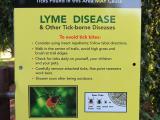In 2022, reported Lyme disease infections were 70% higher than the US average in 2017 to 2019, likely because of a revision in the surveillance case definition, according to research published yesterday in Morbidity and Mortality Weekly Report.
Investigators from the Centers for Disease Control and Prevention (CDC) calculated Lyme disease incidence using 2020 US Census Bureau data as population denominators, comparing the results for 2022 with those of 2017 to 2019.
Reporting burden led to revision
Lyme disease is a bacterial tick-borne illness caused by some species of Borrelia spirochetes. Early signs and symptoms may include a red "bull's eye" rash, fever, and fatigue. If untreated, the infection can affect the heart, joints, and nervous system. Nearly all Lyme disease cases occur in 15 high-incidence areas in the Northeast, mid-Atlantic, and upper Midwest.
As the number of Lyme disease infections has increased, the workload associated with collecting clinical information has proven prohibitive in several high-incidence jurisdictions.
Since the Council of State and Territorial Epidemiologists and the CDC revised the case definition effective on January 1, 2022, high-incidence jurisdictions (those with at least 10 cases per 100,000 population for 3 years) report cases based on lab results alone rather than lab data plus clinical information, the study authors noted. Low-incidence areas still must report clinical data for patients with signs of infection.
"As the number of Lyme disease infections has increased, the workload associated with collecting clinical information has proven prohibitive in several high-incidence jurisdictions, leading to the adoption of modified, jurisdiction-specific surveillance practices," the researchers wrote. "These divergent approaches often precluded the reporting of cases to CDC and prevented accurate comparison of trends across jurisdictions and over time."
Incidence rose the most in older people
In total, 62,551 Lyme disease cases (59,734 from high-incidence areas and 2,817 from low-incidence jurisdictions) were reported to the CDC in 2022—1.7 times the yearly average of 37,118 cases documented in 2017 to 2019. This represents a 72.9% increase in high-incidence areas and a 10.0% rise in those with low rates.
In 2022, 95.5% of cases were reported from high-incidence jurisdictions, compared with an average of 93.1% in 2017 to 2019. Lyme disease incidence in 2022 (18.9 cases per 100,000 people) was 68.8% higher than that in 2017 to 2019 (11.2 per 100,000).
Increase in Lyme disease cases in 2022 likely reflects changes in surveillance methods rather than change in disease risk.
Also in 2022, the median rate in high-incidence areas (68.3 cases per 100,000) was 58% higher than that in 2017 to 2019 (43.3 per 100,000), although the median rate in low-incidence areas (0.52 cases per 100,000) was 24% lower than in the earlier period (0.68 per 100,000).
Incidence rose the most in older people in 2022, with twice as many cases documented in those aged 65 and older as reported in 2017 to 2019. The 2022 incidence in children aged 5 to 9 years (16.5 cases per 100,000) was 11.5% higher than the earlier average (14.8 per 100,000).
Among adults aged 75 to 79, 2022 incidence (38.3 per 100,000) was 2.2 times the 2017 to 2019 average (17.3 per 100,000). More cases were reported in men than women in both 2022 (57.3%) and 2017 to 2019 (57.7%).
"Increase in Lyme disease cases in 2022 likely reflects changes in surveillance methods rather than change in disease risk," the researchers wrote. "The case definition change improves standardization of surveillance across jurisdictions but precludes detailed comparison with historical data."


















